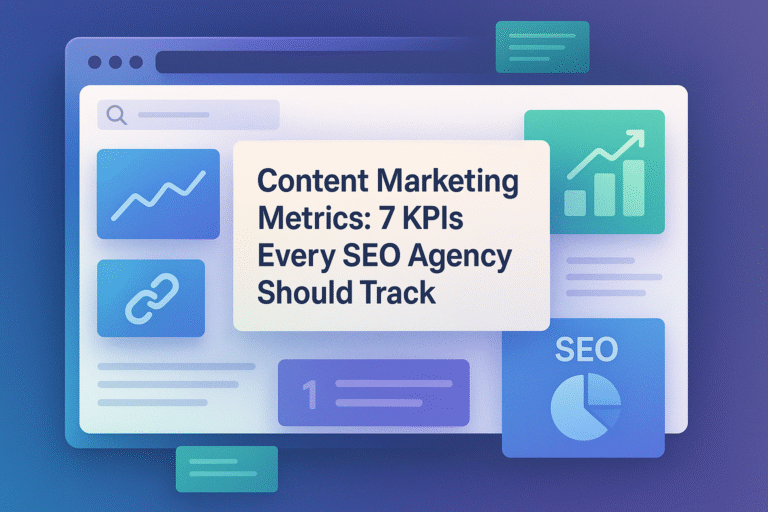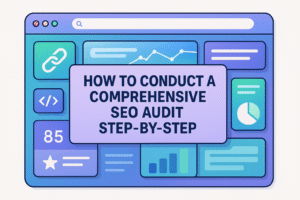In the dynamic realm of content marketing, staying at the forefront requires not only creating compelling content but also analyzing its performance with precision. For SEO agencies, leveraging precise KPIs is crucial—it distinguishes effective strategies from missed opportunities. Key Performance Indicators (KPIs) deliver essential insights into content’s audience resonance, empowering businesses to refine their online presence.
By meticulously tracking diverse metrics, agencies can assess everything from organic search traffic to engagement rates, illuminating the road to success. Each KPI delivers a distinct perspective on a website’s performance, from keyword rankings that highlight search visibility to conversion rates that measure content efficacy. Mastering these metrics allows agencies to fine-tune strategies, ensuring superior outcomes for their clients.
This article examines seven critical KPIs every SEO agency must monitor. We scrutinize how these metrics cultivate a comprehensive understanding of content marketing performance, guaranteeing digital strategies not only reach but also engage and convert your target audience effectively.
Understanding the Role of KPIs in Content Marketing
Understanding the role of Key Performance Indicators (KPIs) in content marketing is essential for optimizing your strategy and achieving business objectives. These measurable values, such as organic search traffic, keyword rankings, and conversion rates, provide insights into how effectively your content is performing.
Tracking content marketing metrics offers several benefits. It helps evaluate content effectiveness, measure ROI, understand audience preferences, improve SEO performance, and align with business goals. For instance, engagement metrics—like views, traffic sources, and average time spent on content—help assess user resonance with your strategy.
Here’s a quick list of critical KPIs to monitor:
- Organic Search Traffic – Assesses visibility on search engines.
- Keyword Rankings – Evaluates SEO effectiveness.
- Conversion Rates – Measures actions taken by potential customers.
- Social Shares – Indicates content’s external influence and reach.
Monitoring these KPIs ensures your content marketing efforts are on track and align with larger business objectives. Use tools like Google Analytics to dive deeper into these metrics and tailor your content marketing strategies for better success. Proper KPI tracking facilitates better engagement rates and identifies opportunities for content improvement, ultimately enhancing user experience and driving content marketing ROI.
Organic Search Traffic: Measuring Discovery
Organic search traffic is a critical content marketing metric reflecting the number of visitors arriving at a site through unpaid search engine results. This data provides valuable insights into how effectively content ranks in search engine results pages (SERPs) and indicates the success of content marketing efforts.
Tracking organic search traffic is essential for assessing the impact of SEO strategies, user intentions, and the performance of specific keywords. Tools like Google Analytics are indispensable for monitoring these trends over time. These tools help distinguish organic search traffic from paid search, as it incurs no advertising costs, presenting sustained value without continual expenditure.
A steady increase in organic search traffic signals growing authority and enhanced visibility, while any decline might indicate a need for SEO optimization. Monitoring traffic through reports such as Google Analytics 4’s “Pages and Screens” can highlight which pages are most effective at attracting user engagement.
For content marketers aiming to improve keyword rankings and achieve content marketing success, focusing on organic search traffic offers a roadmap to refining strategies and enhancing user experience. By understanding and optimizing these metrics, brands can boost their reach and conversion rates more effectively.
Keyword Rankings: Gauging Search Visibility
Keyword rankings are crucial in content marketing as they gauge where a specific keyword stands on search engine results pages (SERPs). Higher rankings enhance visibility, driving more impressions, clicks, and traffic since users often focus on top search results. Tools like Ahrefs and Semrush track keyword performance across different platforms, providing insights that refine content marketing strategies.
Tracking keyword rankings helps assess the effectiveness of your SEO strategies. Here is why monitoring keyword rankings is vital:
– Visibility: Determines how easily your content can be found by your target audience.
– Traffic: Higher-ranked keywords attract more organic search traffic.
– Performance: Guides further optimization efforts by identifying improvements.
– Competitive Insights: Offers a perspective on where you stand compared to competitors.
Tools for Tracking Keyword Rankings:
| Tool | Features |
| Ahrefs | Tracks performance, identifies opportunities |
| Semrush | Offers competitive insights and keyword tracking |
By keeping a close eye on keyword rankings, content marketers can effectively maintain and boost their content marketing success, ensuring steady organic traffic and improved search visibility.
Click-Through Rates (CTR): Assessing User Engagement
Click-through rate (CTR) is a vital content marketing metric that measures the percentage of users who click on a specific link out of those who viewed it. This metric plays a crucial role in assessing user engagement and the effectiveness of content marketing strategies. A high CTR indicates successful traffic generation to websites or landing pages, paving the way for potential conversions.
In content marketing efforts, CTR is particularly useful for evaluating the effectiveness of headlines, meta descriptions, and call-to-action (CTA) elements. By analyzing CTR along with the number of impressions, content marketers can gain valuable insights into content performance. For instance, a low CTR might suggest the need for adjustments to title tags or meta descriptions.
To optimize CTR, marketers can make strategic changes to content language and CTA formulations. These adjustments can significantly enhance user engagement, directing more traffic from organic search traffic, social media platforms, and email newsletters.
Key Factors Influencing CTR:
– Attractive headlines
– Relevant meta descriptions
– Compelling CTAs
Evaluating CTR as part of a content marketing campaign helps in achieving content marketing goals and improving the overall user experience.
Backlinks: Building Authority and Reach
Backlinks play a pivotal role in building authority and expanding reach in the digital landscape. They are essential for SEO, influencing search engine rankings by illustrating that other reputable sites value your content. This is crucial for improved search engine visibility and subsequently increases the likelihood of attracting visitors.
Monitoring backlinks is critical to assess a website’s legitimacy and authority within Google’s algorithm. High-quality backlinks, especially those from reputable sources, are a significant ranking factor. They contribute to a site’s overall authority and ability to rank higher in search results.
Benefits of Backlinks:
– Enhanced Domain Authority: Boosts credibility and trust within search engines.
– Improved Visibility: Higher chances of appearing in top search results.
– Increased Traffic: Leads to more visitors, hence potential customers.
Table: Key Aspects of Backlinks
| Aspect | Importance |
| Source Quality | Reputable sources indicate high content value |
| Quantity | More backlinks can enhance authority |
| Relevance | Relevant backlinks improve user experience |
In conclusion, a successful backlinking strategy not only enhances domain authority but also paves the way for achieving content marketing goals and engaging a broader audience.
Traffic Sources: Decoding User Pathways
Traffic sources are fundamental in understanding how users find their way to your website or app. These sources include organic search, direct visits, referrals, organic social, and paid search. Each channel provides unique insights into which paths contribute the most to your overall website traffic.
Google Analytics 4 (GA4) offers detailed reports on these traffic channels. By navigating to the Acquisition report, you can explore both User Acquisition and Traffic Acquisition views to gain a deeper understanding of user pathways.
Analyzing traffic sources is crucial for refining your marketing strategy. It helps identify which channels drive valuable traffic and guides adjustments to maximize performance. Understanding where your visitors are coming from aids in making informed decisions about time and resource allocation, pinpointing successful channels and those that need optimization.
Here’s a breakdown of common traffic sources:
– Organic Search: Users find you through search engines.
– Direct Visits: Users navigate to your site directly, perhaps via a bookmark.
– Referrals: Traffic arrives from links on other websites.
– Social Media: Platforms like Facebook and Twitter drive this traffic.
– Paid Search: Visitors come through paid advertisements.
By understanding these channels, you can better evaluate marketing effectiveness and refine your content marketing strategies.
Conversion Rate: Evaluating Content Effectiveness
Conversion rate is a key metric in evaluating the effectiveness of content marketing strategies. Defined as the percentage of sessions that result in a conversion—such as a purchase, sign-up, or download—it offers insights into how well your content resonates with your target audience. Monitoring conversion rates helps content marketers assess whether their content marketing efforts align with their goals.
In Google Analytics 4 (GA4), conversion rates can be easily tracked. To view these metrics, navigate to “Reports,” select “Engagement,” and choose the “Conversions” report. This allows businesses to gauge how successfully their content marketing campaigns turn potential customers into actual conversions. The process can be simplified using the Analytify plugin, specifically through its Event Tracking Addon.
Creating conversion events in GA4 is essential for tracking specific goals for various pages. This enables content marketers to understand which pieces of content, such as blog posts or email newsletters, are driving the desired actions from the target audience.
Remember, assessing conversion rates is crucial for optimizing content performance and enhancing user experience. By continually analyzing these metrics, businesses can refine their content marketing strategies to achieve higher engagement rates and content marketing success.
Engagement Metrics: Understanding Audience Interaction
Engagement metrics are invaluable for content marketers aiming to understand how their target audience interacts with their content. High engagement levels, indicated by metrics such as comments per post and session duration, suggest that the content resonates with readers. Conversely, low engagement points to potential areas for improvement in your content marketing strategies.
These metrics not only assess user behavior but also content effectiveness. Tracking them helps optimize content to align with audience preferences, ultimately enhancing content marketing success. However, engagement is complex, influenced by factors like audience size, content relatability, and even algorithm changes on social media platforms.
To effectively track engagement, consider the following key metrics:
– Comments per Post: A direct indicator of audience interaction.
– Session Duration: Measures how long visitors stay engaged on the site.
– Pages per Session: Provides insight into how thoroughly content is explored.
By closely monitoring these metrics, content marketers can refine their strategies to boost engagement, thereby increasing conversion rates and content marketing ROI.
Conclusion: Harnessing KPIs for Strategic Growth
In conclusion, harnessing key performance indicators (KPIs) is crucial for driving strategic growth in content marketing. By focusing on metrics such as keyword rankings, organic search traffic, and engagement rates, content marketers can refine their strategies to boost visibility and search engine performance. Tracking these metrics ensures your content marketing efforts are effectively reaching your target audience and aligning with business goals.
Regular analysis of content metrics, including conversion rates and user engagement, helps identify trends and opportunities across different audience segments. This insight allows for adjustments that support growth and enhance the customer experience. Moreover, understanding content marketing ROI and aligning strategies with business objectives, like increasing sales or improving customer retention, is essential for optimizing content marketing campaigns.
A strategic approach to monitoring KPIs facilitates continuous improvement—ensuring content marketing efforts are not only effective but also contribute meaningfully to overarching business growth. By leveraging these insights, content marketers can tailor their strategies to foster engagement and achieve lasting success.
Key Metrics to Monitor:
– Keyword Rankings
– Organic Search Traffic
– Conversion Rates
– Engagement Rates
– Traffic Sources
Regularly tracking and analyzing these metrics will guide adjustments and enhancements, ultimately supporting your business’s strategic growth.




